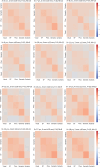Language First, Cognition Later: Different Trajectories of Subcomponents of the Future-Reading Network in Processing Narratives from Kindergarten to Adolescence
- PMID: 38265789
- PMCID: PMC10890959
- DOI: 10.1089/brain.2023.0012
Language First, Cognition Later: Different Trajectories of Subcomponents of the Future-Reading Network in Processing Narratives from Kindergarten to Adolescence
Abstract
Narrative comprehension is a linguistic ability that emerges early in life and has a critical role in language development, reading acquisition, and comprehension. According to the Simple View of Reading model, reading is acquired through word decoding and linguistic comprehension. Here, within and between networks, functional connectivity in several brain networks supporting both language and reading abilities was examined from prereading to proficient reading age in 32 healthy children, ages 5-18 years, scanned annually while listening to stories over 12 years. Functional connectivity changes within and between the networks were assessed and compared between the years using hierarchical linear regression and were related to reading abilities. At prereading age, the networks related to basic language processing accounted for 32.5% of the variation of reading ability at reading age (at 12-14 years) (R2 = 0.325, p = 0.05). At age 17, more complex cognitive networks were involved and accounted for 97.4% of the variation in reading ability (R2 = 0.974, p = 0.022). Overall, networks composing the future-reading network are highly involved in processing narratives along development; however, networks related to semantic, phonological, and syntactic processing predict reading ability earlier in life, and more complex networks predict reading proficiency later in life.
Keywords: child development; executive functions; functional connectivity; language; narrative comprehension; reading.
Conflict of interest statement
No competing financial interests exist.
Figures




Similar articles
-
Maternal reading fluency is associated with functional connectivity between the child's future reading network and regions related to executive functions and language processing in preschool-age children.Brain Cogn. 2019 Apr;131:87-93. doi: 10.1016/j.bandc.2018.11.010. Epub 2018 Dec 13. Brain Cogn. 2019. PMID: 30553572
-
Maternal education as an environmental factor related to reading in children with reading difficulties: A functional magnetic resonance imaging study.Dyslexia. 2023 Aug;29(3):217-234. doi: 10.1002/dys.1744. Epub 2023 Jun 1. Dyslexia. 2023. PMID: 37264693
-
Overlapping neural circuitry for narrative comprehension and proficient reading in children and adolescents.Neuropsychologia. 2013 Nov;51(13):2651-62. doi: 10.1016/j.neuropsychologia.2013.09.002. Epub 2013 Sep 9. Neuropsychologia. 2013. PMID: 24029377
-
Maternal reading fluency is positively associated with greater functional connectivity between the child's future reading network and regions related to executive functions and language processing in preschool-age children.Brain Cogn. 2018 Mar;121:17-23. doi: 10.1016/j.bandc.2018.01.003. Epub 2018 Jan 6. Brain Cogn. 2018. PMID: 29316485
-
On the importance of listening comprehension.Int J Speech Lang Pathol. 2014 Jun;16(3):199-207. doi: 10.3109/17549507.2014.904441. Int J Speech Lang Pathol. 2014. PMID: 24833426 Free PMC article. Review.
Cited by
-
A cross-age odyssey of cognitive reading attributes: a scoping review.Front Psychol. 2025 Jun 20;16:1605898. doi: 10.3389/fpsyg.2025.1605898. eCollection 2025. Front Psychol. 2025. PMID: 40620924 Free PMC article.
References
-
- Archer AL, Gleason MM, Vachon VL. Decoding and fluency: Foundation skills for struggling older readers. Learn Disabil Quart 2003;26:89–101.
-
- Breznitz Z. Fluency in Reading: Synchronization of Processes. Lawrence Erlbaum Associates: Mahwah, NJ, USA; 2006.
-
- Breznitz Z, Misra M. Speed of processing of the visual-orthographic and auditory-phonological systems in adult dyslexics: The contribution of “asynchrony” to word recognition deficits. Brain Lang 2003;85:486–502. - PubMed
-
- Carrow-Woolfolk E. Oral and written language scales (OWLS). American Guidance Service: Circle Pines, MN; 1995.
-
- Cartwright KB Insights from cognitive neuroscience: The importance of executive function for early reading development and education. Early Educ Dev 2012;23:24–36.
Publication types
MeSH terms
Grants and funding
LinkOut - more resources
Full Text Sources
Medical

